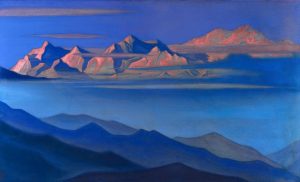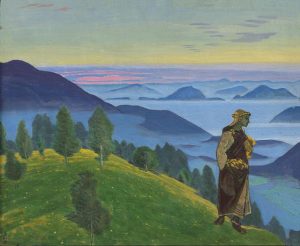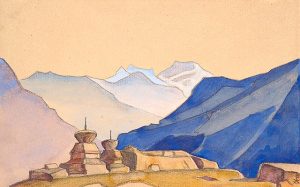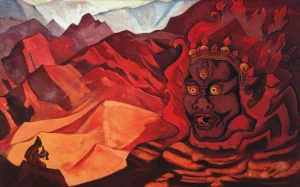Contemporary theosophy includes the consideration of all roots. One of these roots can be found in the “West” in the Rosicrucian teachings. How can we present a “picture” of this teaching and philosophy here in brief?
To remain in the concept of a picture, we recommend looking at pictures by the great painter Caspar David Friedrich.
In the esoteric training of the Rosicrucians, there is a special relationship to nature and the spiritual experiences on and in it. The paintings by C.D.F. show examples of this training path.
R. Steiner describes two of these training experiences. First there is a stay on a mountain in a meditative mood, in the sense of a sublime mood of the soul. The picture of the hiker by C.D.F., who is probably standing on a low mountain rock with a walking stick, shows this. Another experience of the path of training is the stay in a mine or gallery under the earth with a meditative experience that is supposed to correspond to this situation. There is a little-noticed picture of an entrance to a gallery where a stele with the image of an angel can be seen on the left. In the background there is probably a fire burning in a stove. This picture is dedicated to the described experience under the earth.
Many other paintings by C.D.F. show natural forces and experiences of nature as well as the experience of loneliness, friendship and relationships. From the contemplation of these pictures – for nature does not keep them freely available every day – soul forces for the development of an ethical humanity are to strengthen in the seeker.
With these images C.D.F. creates a connection to the world of thoughts of the Rosicrucian teachings. This also creates a connection to R. Steiner’s anthroposophy, because in many of his lectures Steiner gives further content to this teaching. The philosophical-theoretical basis of the teaching can be found in his book “Secret Science in Outline”.
The contemplation of art is a legitimate complementary path of spiritual development.
If one follows Steiner’s distinction of stating a Western and an Eastern teaching, the difference is probably ultimately only in the consideration of the outer physical plane. For Rosicrucianism and its offshoot, Anthroposophy, the physical in general and the human physical body are fully present and permanent, at least for a still long period of time. In the Karlsruhe lectures Steiner breaks with an agreement within the Brotherhood by naming the spiritual contained in the physical and emphasising its importance. This emphasis is already contrary in approach to the older Eastern teaching.



Steiner’s motive in this point is thus to distinguish himself from the Eastern Maya teaching in Buddhism, in which the overcoming of the suffering physical life is encouraged. The three Maya veils in the physical, astral and lower mental are to be overcome through an ultimately ascetic way of life and meditation techniques. The goal is to leave the wheel of rebirth. That the spiritual contained in these veils must be transformed in the process is contained in the teaching.
In the West, the aspirant, without the knowledge of reincarnation, wants to go to heaven in the sense of a final resolution of this one life. If he has the knowledge of reincarnation – which is rarely the case – he wants to be reborn advanced into this existing physical world. The seeker in the East strives for Nirvana in order to be redeemed from the wheel of rebirth, whereby the expected bliss has no real basis.
It is now time to refer to the Shamballa teaching as given in the most current form in AGNI YOGA. The spiritual monad, the spiritual nucleus that externalises itself in man, has an infinite wandering through many incarnations before it, without heaven or Nirvana. Nirvana is merely a possible state of rest for intermediate periods of the wandering, before a new, higher task ends this state or an incarnation – no matter in which dimension – must take place for the necessary karmic balancing. If one succeeds in the next ascent, the responsibility and the task, i.e. the work, grow on the basis of the level attained. Even a Buddha does not spend his existence in blissful self-satisfaction. The activity of M. described in the diaries of Helena Roerich to fight off the dark adversary forces on higher levels, in the at times daily struggle, is an example and should erase any illusion of romantic expectations for salvation.
The greatest conceivable most comprehensive life – the macrocosm – – exists and pulsates and thus the human spiritual monads in their shells pulsate equally and indefinitely. This truth cannot be thought through to its end, it is unlimited. It is only the question on what level and with what task the human being wants to work and how he can overcome his comfort.
The esoteric teaching of the West must recognise that for the earthly and solar system the nadir of the descent of spirit into matter has been passed and this cycle is again moving in the direction of spiritual origin. These are great periods in human life. The body used by man in the new cycle of time already begun will be the condensed astral. To what extent this will require a new planet with a corresponding relocation of parts of present-day humanity is an open question, but it is becoming more and more probable. The Shamballa teaching of Agni Yoga with its principle of unlimited learning and working, also on the higher planes, resolves the apparent contradiction of the two past hemispheric teachings and finally emphasises the unalterable truth of reincarnation.
The current work of the Christ from the high standpoint described by the Tibetan is the approach of Shamballa to the other centres of the Spiritual Hierarchy so that Will and Love may work in increasing synthesis.




